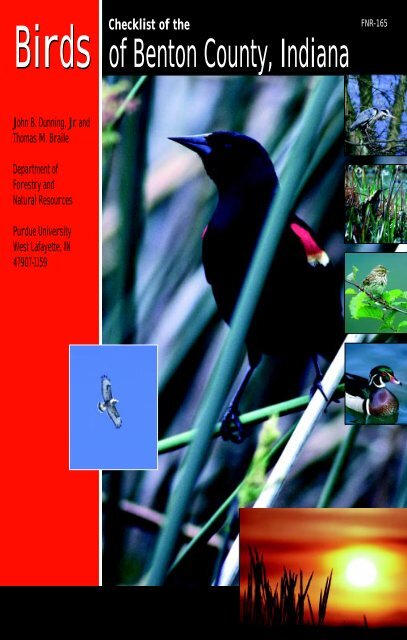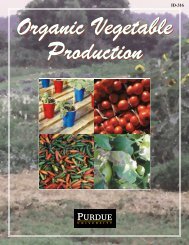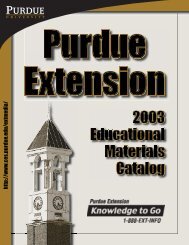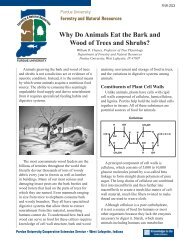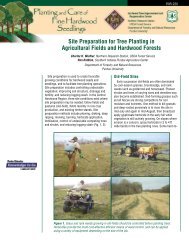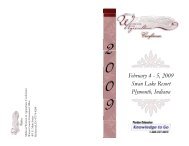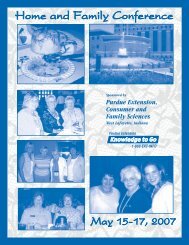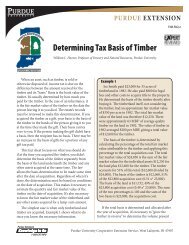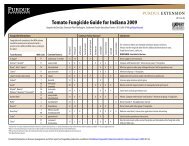Birds of Benton County, Indiana - Purdue Extension - Purdue ...
Birds of Benton County, Indiana - Purdue Extension - Purdue ...
Birds of Benton County, Indiana - Purdue Extension - Purdue ...
Create successful ePaper yourself
Turn your PDF publications into a flip-book with our unique Google optimized e-Paper software.
<strong>Birds</strong><br />
Checklist <strong>of</strong> the<br />
<strong>Birds</strong> <strong>of</strong> <strong>Benton</strong> <strong>County</strong>, <strong>Indiana</strong><br />
John B. Dunning, Jr. and<br />
Thomas M. Braile<br />
Department <strong>of</strong><br />
Forestry and<br />
Natural Resources<br />
<strong>Purdue</strong> University<br />
West Lafayette, IN<br />
47907-1159<br />
FNR-165
Checklist <strong>of</strong> the<br />
<strong>Birds</strong> <strong>of</strong> <strong>Benton</strong> <strong>County</strong>, <strong>Indiana</strong><br />
John B. Dunning, Jr. and Thomas M. Braile<br />
Department <strong>of</strong> Forestry and Natural Resources, <strong>Purdue</strong> University<br />
<strong>Benton</strong> <strong>County</strong> <strong>of</strong>fers birders in<br />
<strong>Indiana</strong> interesting opportunities to<br />
see a variety <strong>of</strong> native birds. The<br />
county is located in the<br />
portion <strong>of</strong> the state<br />
that was dominated by<br />
prairies, and historically<br />
supported many<br />
grassland birds. The<br />
amount <strong>of</strong> forest in the<br />
county has always<br />
been small, and was<br />
further reduced by the<br />
clearing <strong>of</strong> many<br />
woodlots and streamside<br />
vegetation. Thus,<br />
few woodland birds are<br />
widespread. Because<br />
<strong>of</strong> these land-use practices, the<br />
typical birds for <strong>Benton</strong> <strong>County</strong> are<br />
grassland specialists and opencountry<br />
birds such as Grasshopper<br />
Sparrows and Horned Larks, rather<br />
than the familiar woodland birds<br />
such as chickadees and woodpeckers.<br />
Much <strong>of</strong> the former prairie was<br />
converted to agriculture long ago,<br />
greatly reducing the birding opportunities<br />
in the county. Little <strong>of</strong> this<br />
land has been restored to natural<br />
habitat. For instance, there has been<br />
little county acreage enrolled in the<br />
Conservation Reserve Program which<br />
encourages farmers to restore grass-<br />
3<br />
land habitat on their land. In the<br />
1990s, however, the <strong>Indiana</strong> Department<br />
<strong>of</strong> Natural Resources purchased<br />
several properties and<br />
began restoring wetland<br />
and grassland<br />
habitats. Today, the<br />
Pine Creek Gamebird<br />
Habitat Area in southeastern<br />
<strong>Benton</strong><br />
<strong>County</strong> provides an<br />
outstanding birding<br />
opportunity for<br />
visitors.<br />
Pine Creek<br />
Gamebird<br />
Habitat Area<br />
In the early 1990s, the <strong>Indiana</strong><br />
Department <strong>of</strong> Natural Resources<br />
purchased 700 acres to create habitat<br />
for pheasants and quail. The<br />
land was farmed prior to this purchase.<br />
In 1995, Ducks Unlimited<br />
and the <strong>Indiana</strong> Department <strong>of</strong><br />
Natural Resources collaborated on a<br />
wetland restoration project that<br />
created 100-150 acres <strong>of</strong> open wetlands<br />
by damming the old drainage<br />
ditches on the property in a way<br />
that created a series <strong>of</strong> wetland<br />
basins.<br />
The water levels in the wetlands are<br />
determined by local rainfall, so the
Checklist <strong>of</strong> the <strong>Birds</strong> <strong>of</strong> <strong>Benton</strong> <strong>County</strong><br />
amount and kind <strong>of</strong> wetland habitats<br />
vary from season to season. A wide<br />
variety <strong>of</strong> wetland birds find the<br />
diversity <strong>of</strong> wetlands attractive, and<br />
migratory ducks and shorebirds<br />
began using the wetlands almost as<br />
soon as they were created. As a<br />
wetland plant<br />
community<br />
developed,<br />
herons, egrets,<br />
kingfishers, and<br />
many other birds<br />
settled into the<br />
area. In 1997,<br />
the wetland was<br />
formally dedicated<br />
as the<br />
Robert Feldt<br />
Marsh, honoring<br />
a retired DNR<br />
wildlife biologist.<br />
Water began<br />
accumulating in the restored wetlands<br />
in spring 1996. Since that<br />
time, 183 bird species have been<br />
recorded at Pine Creek, including<br />
such <strong>Indiana</strong> rarities as Hudsonian<br />
Godwit, American White Pelican,<br />
Bald Eagle, Black-necked Stilt, and<br />
American Avocet. The agricultural<br />
fields on private lands surrounding<br />
the refuge provide habitat for migratory<br />
shorebirds such as American<br />
Golden-Plovers in the spring, and<br />
rare open-country birds, such as<br />
Smith’s Longspur, in the winter.<br />
The checklist summarizes (page 7)<br />
the current status <strong>of</strong> birds in <strong>Benton</strong><br />
<strong>County</strong>, emphasizing the records<br />
accumulated during studies at the<br />
Pine Creek Gamebird Habitat Area<br />
4<br />
since the restoration <strong>of</strong> wetlands<br />
began in March 1996. Because Pine<br />
Creek does not completely represent<br />
all habitats present in the county,<br />
data has been supplemented with<br />
other records to reflect the status <strong>of</strong><br />
birds common in towns and woodlands.<br />
The Atlas <strong>of</strong> Breeding <strong>Birds</strong> <strong>of</strong><br />
<strong>Indiana</strong>, was consulted, as were the<br />
historical records compiled by Dr.<br />
Russell Mumford while he wrote The<br />
<strong>Birds</strong> <strong>of</strong> <strong>Indiana</strong>. Records from local<br />
birders and county residents were<br />
solicited as well.<br />
Since intensive studies <strong>of</strong> the<br />
county’s birds began only in 1996,<br />
new information will improve knowledge<br />
<strong>of</strong> local distribution and status<br />
<strong>of</strong> many <strong>of</strong> the birds found in <strong>Benton</strong><br />
<strong>County</strong>. Thus, the checklist should<br />
be considered a summary <strong>of</strong> current<br />
knowledge that will be updated as<br />
new records accumulate. Birders<br />
with additional or new records are<br />
urged to contact the authors (address<br />
on cover).<br />
Definitions<br />
The seasons are as follows:<br />
Spring = March—May<br />
Summer = June—August<br />
Fall = September—November<br />
Winter = December—February<br />
These definitions are somewhat<br />
arbitrary and do not accurately<br />
reflect seasonal status in all cases.<br />
For instance, in February 1998, an<br />
early thaw caused many waterfowl to<br />
migrate into the Pine Creek area.<br />
These waterfowl records are summarized<br />
in the winter portion <strong>of</strong> the<br />
checklist because they were recorded
in February, but the<br />
birds were really early<br />
spring migrants. It is<br />
better to use consistent<br />
season definitions than<br />
to vary the definitions<br />
for each taxonomic<br />
group. Deviations from<br />
these rules occurred when dealing<br />
with shorebirds, which migrate<br />
through <strong>Benton</strong> <strong>County</strong> in April,<br />
May, and early June (spring migrants)<br />
and again during July—<br />
October (fall migrants). Of all the<br />
shorebirds reported for the area,<br />
only the Killdeer, Spotted Sandpiper,<br />
Upland Sandpiper, and American<br />
Woodcock are potential breeders in<br />
the area and therefore can accurately<br />
be called “summering” birds.<br />
It would be confusing to report<br />
June—August shorebird records as<br />
“summer” birds as this might imply<br />
they were breeding. Therefore, with<br />
the exception <strong>of</strong> these four species,<br />
March—June records <strong>of</strong> shorebirds<br />
are reported as spring migrants, and<br />
all July—November records as fall<br />
migrants.<br />
5<br />
Checklist <strong>of</strong> the <strong>Birds</strong> <strong>of</strong> <strong>Benton</strong> <strong>County</strong><br />
Status codes used in the<br />
checklist are defined as<br />
follows: Common (C):<br />
recorded in moderate to<br />
large numbers on >50%<br />
<strong>of</strong> the trips in a season;<br />
Uncommon (U): recorded<br />
in small numbers<br />
on 10-49% <strong>of</strong> the trips in a season;<br />
Rare (R): recorded in small numbers<br />
on
Checklist <strong>of</strong> the <strong>Birds</strong> <strong>of</strong> <strong>Benton</strong> <strong>County</strong><br />
Access<br />
The Pine Creek Gamebird Habitat<br />
Area can be reached by driving north<br />
from State Highway 18 on <strong>County</strong><br />
Road 850 East. After 2 miles, turn<br />
right (east) on <strong>County</strong> Road 200<br />
North. This road will take you right<br />
through the refuge. Several parking<br />
lots are marked along <strong>County</strong> Road<br />
200 North. Parking Lot #3 (up the<br />
hill after the county road crosses the<br />
marsh) is a convenient place to start.<br />
Most <strong>of</strong> the wetlands can be scanned<br />
with a spotting scope from the bluffs<br />
north <strong>of</strong> <strong>County</strong> Road 200 North<br />
across from Parking Lot #3. Do not<br />
park on the county road as it crosses<br />
the marsh (you will block passage <strong>of</strong><br />
local farm equipment).<br />
The entire Pine Creek refuge is open<br />
for birding except during the fall<br />
hunting seasons. Hunters have<br />
priority access during early fall teal<br />
season, regular fall waterfowl season,<br />
and late fall pheasant season. Dates<br />
for these seasons are set annually by<br />
the <strong>Indiana</strong> Department <strong>of</strong> Natural<br />
Resources. The portion <strong>of</strong> the refuge<br />
south <strong>of</strong> <strong>County</strong> Road 200 North is<br />
closed to all (including hunters)<br />
during waterfowl seasons to provide a<br />
protected resting area for ducks and<br />
geese. During breeding season,<br />
walking in mowed pathways will<br />
reduce the chances <strong>of</strong> accidentally<br />
stepping on duck, pheasant, or<br />
songbird nests concealed in the<br />
grass.<br />
During winter and spring, interesting<br />
birds can be seen on agricultural<br />
fields throughout the county, including<br />
migrating shorebirds (peaking in<br />
6<br />
April and early May), and Smith’s and<br />
Lapland Longspurs, Vesper Sparrows<br />
and Horned Larks (December—<br />
March). These fields are private<br />
property, and birders should not<br />
trespass. Many <strong>of</strong> these birds can be<br />
seen or heard by driving slowly along<br />
the county roads. A spotting scope is<br />
useful.<br />
Acknowledgments<br />
The <strong>Indiana</strong> Department <strong>of</strong> Natural<br />
Resources, Division <strong>of</strong> Fish and Wildlife,<br />
Nongame Program funded the<br />
surveys <strong>of</strong> the birds <strong>of</strong> Pine Creek<br />
Gamebird Habitat Area. Bob Porch<br />
helped coordinate activities with<br />
other uses <strong>of</strong> the refuge. Thanks to<br />
Homer Erickson, Carl & Cindy<br />
Voglewede, Colleen Sherman, Florence<br />
Sanchez, Susan Ulrich, and Marion<br />
Brazes for sharing their records, and<br />
Harmon Weeks for reviewing the<br />
checklist.<br />
Photos <strong>of</strong> American Bittern, Sparrow, Wood Duck, and<br />
Hawk by Rick and Nora Bowers.<br />
Editing: Jane Wolf Brown Design: Russ Merzdorf Layout: Erin Pliley
SPECIES BREEDING SPRING SUMMER FALL WINTER<br />
Common Loon R R<br />
Pied-billed Grebe B C U C<br />
Horned Grebe U<br />
Red-necked Grebe A<br />
American White Pelican A<br />
Double-crested Cormorant C C C<br />
American Bittern U R R<br />
Least Bittern R<br />
Great Blue Heron B C C C U<br />
Great Egret U C C<br />
Little Blue Heron R R<br />
Cattle Egret R<br />
Green Heron B U C R<br />
Black-crowned Night-Heron R R R<br />
Yellow-crowned Night-Heron R<br />
Glossy/White-faced Ibis A<br />
Tundra Swan R R<br />
Greater White-fronted Goose R<br />
Snow Goose R R<br />
Canada Goose B C C C C<br />
Wood Duck B U C C U<br />
Green-winged Teal U R C<br />
American Black Duck R R U<br />
Mallard B C C C C<br />
Northern Pintail U U U<br />
Blue-winged Teal B C C C<br />
Northern Shoveler C C R<br />
Gadwall U U U<br />
American Wigeon U C U<br />
Canvasback R R R<br />
Redhead R R U<br />
Ring-necked Duck U R U<br />
Lesser Scaup C R U<br />
Common Goldeneye R R<br />
Bufflehead U R U<br />
Hooded Merganser B U R R R<br />
Common Merganser R<br />
Red-breasted Merganser R A R<br />
Ruddy Duck U<br />
Turkey Vulture B C C C R<br />
Osprey R R<br />
Bald Eagle R R<br />
Northern Harrier C R C C<br />
Sharp-shinned Hawk R<br />
Cooper’s Hawk U U U<br />
Broad-winged Hawk R<br />
Red-tailed Hawk B C C C C<br />
Rough-legged Hawk R R U<br />
American Kestrel B U U U C<br />
Merlin R U<br />
Peregrine Falcon R R<br />
Ring-necked Pheasant B C C C C<br />
Greater Prairie-Chicken H H H H H<br />
Wild Turkey R R<br />
Northern Bobwhite B U U U U<br />
King Rail R<br />
Virginia Rail U R<br />
Sora R U R<br />
American Coot C U C U<br />
Sandhill Crane U U U<br />
Black-bellied Plover R R<br />
7<br />
Checklist <strong>of</strong> the <strong>Birds</strong> <strong>of</strong> <strong>Benton</strong> <strong>County</strong>
Checklist <strong>of</strong> the <strong>Birds</strong> <strong>of</strong> <strong>Benton</strong> <strong>County</strong><br />
SPECIES BREEDING SPRING SUMMER FALL WINTER<br />
American Golden-Plover C U<br />
Semipalmated Plover U U<br />
Killdeer B C C C U<br />
Black-necked Stilt A<br />
American Avocet A<br />
Greater Yellowlegs U U<br />
Lesser Yellowlegs C C<br />
Solitary Sandpiper R U<br />
Spotted Sandpiper B U U R<br />
Upland Sandpiper B R U<br />
Hudsonian Godwit R<br />
Marbled Godwit R<br />
Sanderling R<br />
Semipalmated Sandpiper U U<br />
Western Sandpiper R R<br />
Least Sandpiper C C<br />
White-rumped Sandpiper R R<br />
Baird’s Sandpiper R<br />
Pectoral Sandpiper C C<br />
Dunlin U U<br />
Stilt Sandpiper R U<br />
Buff-breasted Sandpiper R<br />
Short-billed Dowitcher R R<br />
Long-billed Dowitcher R R<br />
Common Snipe C U<br />
American Woodcock R U R<br />
Wilson’s Phalarope R R<br />
Red-necked Phalarope R<br />
Franklin’s Gull R<br />
Bonaparte’s Gull R R<br />
Ring-billed Gull U U U<br />
Caspian Tern R R<br />
Common Tern A<br />
Forster’s Tern U U R<br />
Black Tern U R R<br />
Rock Dove B C C C C<br />
Mourning Dove B C C C C<br />
Black-billed Cuckoo B R R<br />
Yellow-billed Cuckoo B U R<br />
Barn Owl H<br />
Eastern Screech-Owl B U U U U<br />
Great Horned Owl B U U U U<br />
Snowy Owl H<br />
Barred Owl B U U U U<br />
Long-eared Owl H<br />
Short-eared Owl H H<br />
Common Nighthawk R R<br />
Chimney Swift B C C U<br />
Ruby-throated<br />
Hummingbird B U C R<br />
Belted Kingfisher B U C C U<br />
Red-headed<br />
Woodpecker B C C C U<br />
Red-bellied<br />
Woodpecker B C C C C<br />
Yellow-bellied Sapsucker U<br />
Downy Woodpecker B C C C C<br />
Hairy Woodpecker H R C<br />
Northern Flicker B C C C U<br />
8
9<br />
Checklist <strong>of</strong> the <strong>Birds</strong> <strong>of</strong> <strong>Benton</strong> <strong>County</strong><br />
SPECIES BREEDING SPRING SUMMER FALL WINTER<br />
Pileated Woodpecker R<br />
Eastern Wood-Pewee B U C<br />
Yellow-bellied Flycatcher A<br />
Willow Flycatcher B U C<br />
Least Flycatcher R<br />
Eastern Phoebe B U U<br />
Great Crested<br />
Flycatcher B U<br />
Eastern Kingbird B U C U<br />
Horned Lark B C C C C<br />
Purple Martin B R R<br />
Tree Swallow B C C C<br />
N. Rough-winged<br />
Swallow B R U R<br />
Bank Swallow R U<br />
Cliff Swallow U U R<br />
Barn Swallow B U C U<br />
Blue Jay B C C C C<br />
American Crow B C C C C<br />
Carolina Chickadee C C C C<br />
Tufted Titmouse C C C C<br />
Red-breasted Nuthatch U<br />
White-breasted Nuthatch C C C C<br />
Brown Creeper U<br />
Carolina Wren U U<br />
House Wren B C C U<br />
Sedge Wren B R C R<br />
Marsh Wren R<br />
Golden-crowned Kinglet U<br />
Ruby-crowned Kinglet R R<br />
Blue-gray Gnatcatcher R<br />
Eastern Bluebird B C C U<br />
Veery R R<br />
Gray-cheeked Thrush U<br />
Swainson’s Thrush C<br />
Hermit Thrush R<br />
Wood Thrush R U<br />
American Robin B C C C H<br />
Gray Catbird B U C U<br />
Northern Mockingbird B U U R R<br />
Brown Thrasher B C C<br />
American Pipit C R<br />
Cedar Waxwing B U U U H<br />
Loggerhead Shrike H H<br />
European Starling B C C C C<br />
White-eyed Vireo R R<br />
Bell’s Vireo R R<br />
Blue-headed Vireo R<br />
Yellow-throated Vireo R<br />
Warbling Vireo B R R<br />
Red-eyed Vireo R<br />
Golden-winged Warbler R<br />
Tennessee Warbler R R R<br />
Nashville Warbler R<br />
Northern Parula R<br />
Yellow Warbler B U C R<br />
Chestnut-sided Warbler R<br />
Magnolia Warbler R<br />
Yellow-rumped Warbler C C
SPECIES BREEDING SPRING SUMMER FALL WINTER<br />
Black-throated Green Warbler R<br />
Blackburnian Warbler R<br />
Yellow-throated Warbler R<br />
Palm Warbler U U<br />
Bay-breasted Warbler H<br />
Blackpoll Warbler R<br />
Black-and-white Warbler R<br />
American Redstart R<br />
Ovenbird U U<br />
Northern Waterthrush R<br />
Kentucky Warbler R<br />
Connecticut Warbler R<br />
Mourning Warbler R<br />
Common Yellowthroat B C C U<br />
Wilson’s Warbler R<br />
Yellow-breasted Chat R<br />
Summer Tanager R R<br />
Scarlet Tanager R<br />
Northern Cardinal B C C C C<br />
Rose-breasted Grosbeak C C<br />
Indigo Bunting B U C R<br />
Dickcissel B U C<br />
Eastern Towhee B C C<br />
American Tree Sparrow U U C<br />
Chipping Sparrow B C C R<br />
Field Sparrow B C C U<br />
Vesper Sparrow B U U U U<br />
Savannah Sparrow B U U C U<br />
Grasshopper Sparrow B U U<br />
Fox Sparrow R U<br />
Song Sparrow B C C C C<br />
Lincoln’s Sparrow U<br />
Swamp Sparrow U R U U<br />
White-throated Sparrow U U<br />
White-crowned Sparrow U U U<br />
Dark-eyed Junco R U C<br />
Lapland Longspur U<br />
Smith’s Longspur R<br />
Bobolink B U U<br />
Red-winged Blackbird B C C C C<br />
Eastern Meadowlark B C C C U<br />
Western Meadowlark B R<br />
Rusty Blackbird U<br />
Common Grackle B C C C C<br />
Brown-headed Cowbird B C C C U<br />
Orchard Oriole B U U<br />
Baltimore Oriole B C C<br />
Purple Finch R R<br />
House Finch B C C C C<br />
White-winged Crossbill A<br />
Common Redpoll R<br />
Pine Siskin U<br />
American Goldfinch B C C C C<br />
Evening Grosbeak R R<br />
House Sparrow B C C C C<br />
10
Checklist <strong>of</strong> the<br />
<strong>Birds</strong> <strong>of</strong> <strong>Benton</strong> <strong>County</strong>, <strong>Indiana</strong><br />
This material may be available in alternative formats.<br />
It is the policy <strong>of</strong> the <strong>Purdue</strong> University Cooperative <strong>Extension</strong> Service <strong>of</strong> <strong>Purdue</strong> University that all<br />
persons shall have equal opportunity and access to its programs and facilities without regard<br />
to race, color, sex, religion, national origin, age, or disability.<br />
<strong>Purdue</strong> University is an Affirmative Action employer.<br />
1-888-EXT-INFO<br />
12<br />
http://www.agcom.purdue.edu/AgCom/Pubs/menu.htm<br />
NEW 12/98 (2M)


